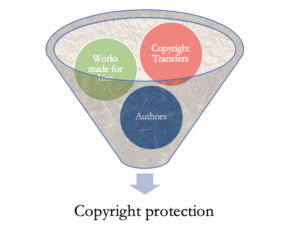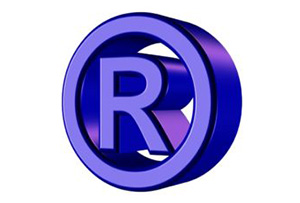Copyright Ownership: What You Should Know Before Signing that Contract (Part 1)

Authors, business owners, and content creators are usually aware of the importance of protecting their innovations, including a business plan, software program, services, and product design. Innovations may be referred to as “intellectual property.” Intellectual property is the broad concept of an intangible creation of the human intellect. One type of intellectual property is copyrights. Copyrights protect certain types of creative works, such as software code, music, photographs, books, and even tattoos. In this article, we identify two essential mechanisms for creating value from works protected by copyrights that serve very different, but significant purposes for creators and licensees of copyrights: (1) “copyright transfers” or “copyright assignments;” and (2) “works made for hire.”
Both copyright transfers and works made for hire enable the author or creator of a work to benefit from the work by allowing the author to receive some type of consideration (most often in the form of monetary compensation), in exchange for certain copyrights to the work. When drafting agreements that memorialize the terms of such transfers, authors and creatives are often confronted with contracts containing provisions written in “legalese” similar to the following:
“In the event, any such work prepared by the Executive for the Company is deemed not to be a work made for hire for any reason, Executive hereby irrevocably grants, transfers and assigns all right, title and interest in such work and all copyrights in such work and all renewals and extensions thereof to the Company…”
Such a provision may be part of “copyright transfer” agreements. These agreements often allude to “works made for hire” as a way of adjusting the rights afforded to a party. The distinction between copyright transfers and works made for hire are critical for creators to understand because the differences between them may have drastically different implications on the ownership rights of the work. Below is a brief explanation of copyright transfers and works made for hire.
Copyright Transfers
A copyright transfer occurs when an author sells their work to someone else. The relevant statute governing copyright transfers is 17 U.S.C § 201. In transfer agreements, the author owns the copyright to their work and transfers (all or partial) right, title, and interest in the work to another party. This typically occurs when a copyright owner wishes to commercially exploit their work and transfers rights to a person or entity (such as a book publisher) who or that is authorized for introducing the work to specific markets. A copyright transfer must be agreed to in a written instrument signed by the copyright owner. In order to transfer interests, title, or right of the work to someone else, the author must own the copyright to the work.
Moreover, once an author transfers their copyright interest(s), they may terminate the transfer 35 to 40 years after the transfer is granted under 17 U.S.C § 203; or 56 years for transfers granted before January 1, 1978, under 17 U.S.C § 304(c). Additionally, termination of a copyright transfer is valid even if the author agreed not to terminate their transfer. In other words, the right to terminate a transfer cannot be waived in advance or contracted away. In Marvel Characters Inc. v. Joseph H. Simon, 310 F.3d 280 (2002), a federal court held that copyright assignments could not require an author to waive his termination rights. In this case, the Court addressed whether an agreement between Joseph Simon and Marvel Comics Inc., in which Simon assigned to Marvel his rights to Captain America Comics, was valid under section 304(c) of the Copyright Act. Finding in favor of Simon, the Court held that “Congress’s purpose behind §304(c) was to prevent authors from waiving their termination right by contract.” The Court in Marvel Characters Inc. asserted that Congress’s intent in drafting Section 304(c) was to ensure that authors had equal bargaining power when negotiating their copyright interests with publishers and marketers. The fact that an author may terminate an assignment of rights after a transfer is very different than if the work is a “work made for hire.”
Works Made for Hire
There are two scenarios that establish that a work is a “work made for hire”: (1) works created by employees within the scope of their employment; and (2) works that are specially commissioned and fall under nine categories listed below AND if the parties expressly agree in a written instrument signed by them that the work shall be considered “work made for hire.” 17 U.S.C § 101. The nine categories of works considered “works made for hire” include:
- a contribution to a collective work;
- a part of a motion picture or other audiovisual work;
- a translation;
- a supplementary work;
- a compilation;
- an instructional text;
- a test;
- answer material for a test; and,
- an atlas.
If the work is not specially commissioned, does not fall under the preceding nine categories, and is not created by an employee within the scope of their employment, then the work is not a “work made for hire.” As a general rule, the copyright in a work is initially owned by the creator of that work. One the other hand, an employer, person, or entity that commissions the work explicitly, owns the copyrights to the work. Determining whether a work is a “work made for hire” is not always clear-cut.
For example, disputes often arise over whether the author was an employee or an independent contractor. This question is imperative for determining whether the work created by the author was a “work made for hire.” In the landmark case of Community for Creative Non-Violence v. Reed, 490 U.S. 730 (1989), the Supreme Court elaborated on the unique circumstances that suggest whether the author of the work is an employee or an independent contractor. The Court also listed eleven (11) non-dispositive factors that should be considered in the absence of a “work made for hire” agreement (e.g., the extent of the hired party’s discretion over when and how long to work, the method of payment, the tax treatment of the hired party). These factors are meant to assist in determining whether a work is a “work made for hire,” whether someone was considered an independent contractor or employee when the work was made, and the degree of control (if any) that another party exercised in the creation of the work.
Recap
One principal difference between a copyright transfer and a “work made for hire” is that a transfer can be terminated while a “work made for hire” cannot. When work is a “work made for hire,” the author of that work never owns the copyright. Although the distinction between works made for hire and copyright transfers appear subtle, having a clear understanding of both can help you adequately protect your intellectual property. Business owners and authors alike should understand how works made for hire laws, and copyright assignment could affect their copyright interests. If you are a business owner, start-up, author, or creative, it is worth spending some time during the early stages of the creative process thinking about which tools can best help you protect your work. Consulting with a copyright attorney is another way to obtain an expert legal opinion on whether you are indeed the owner of a work you have created, or whether you may transfer or terminate your ownership rights.
The attorneys at The Plus IP Firm have extensive experience litigating copyright disputes on behalf of copyright holders, businesses, and parties to copyright agreements. Copyright contracts are but one of the many legal tools we prepare for clients who want to protect their works of art, creation, business, and reputation. To learn more about the IP Plus Firm and how we protect our client’s intellectual property, click HERE. This article was written by Rosa Villa and Derek Fahey. To learn more about Derek Fahey, click HERE.
Copyright ©. This article is for informational purposes only and is not intended as legal advice or solicitation.












